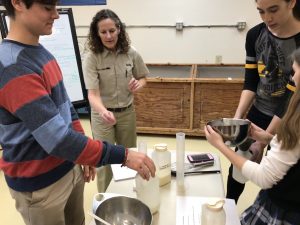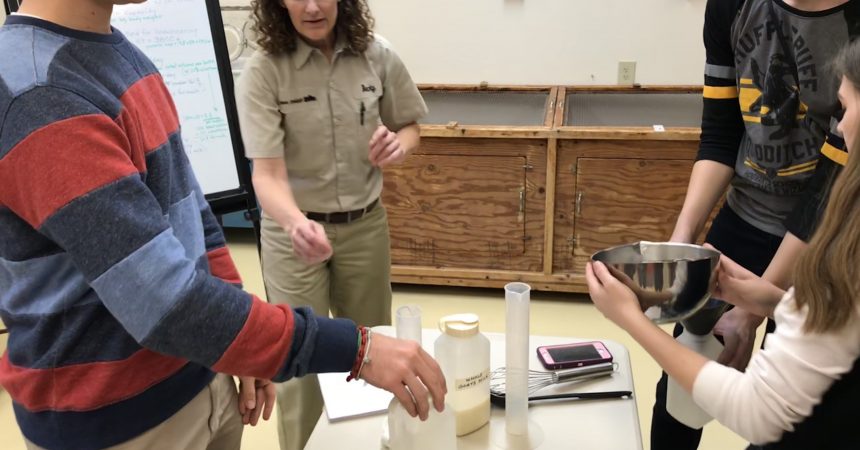Zoo InternQuest is a seven-week career exploration program for San Diego County high school juniors and seniors. Students have the unique opportunity to meet professionals working for the San Diego Zoo, Safari Park, and Institute for Conservation Research, learn about their jobs, and then blog about their experience online. Follow their adventures here on the Zoo’s website!
 Who wouldn’t want to spend their day being paid to care for and work with baby animals?
Who wouldn’t want to spend their day being paid to care for and work with baby animals?
During my first week of Zoo InternQuest, I had the opportunity to meet with Becky Kier, a Senior Keeper in the Neonatal Assisted Care Unit (NACU) at the San Diego Zoo. Ms. Kier’s career initially seemed to be that of a dream– spending her days playing with baby monkeys and cuddling with lion cubs. This, however, is an enormous understatement to the amount of knowledge and labor that goes into the specialized care that each individual baby animal needs to thrive. Her team consists of five full time/part time employees who work unpredictable hours, even working all hours of the night when necessary.
The baby animals who undergo treatment and care in the NACU are typically those who suffer from injury, infection, maternal neglect, maternal death, or an inadequate milk supply. These animals, like human infants, require constant round the clock care. In fact, Ms. Kier and her coworkers provide the love and attentiveness that the baby animal would receive from its mother. While in the care of the nursery staff, baby animals receive round the clock care including: litter marking for identification purposes, morning weights, temperature, bottle-feeding, burping, and medications if necessary. Each one of these processes is crucial to the rehabilitation and care of the baby animal to ensure its well being. In order to make sure every baby is receiving proper nutrition, Ms. Kier and her team use a number of formulas and methods to calculate the body mass index, stomach capacity, and how much formula to create per day.
After a brief presentation, we were given the opportunity to give the process of formula making a shot. Taking into consideration even the smallest of details, we were tasked with creating a formula for a baby Speke’s gazelle. Each species requires a different nipple size, with different sized holes, and in some cases a custom nipple needs to be created. By making sure each baby animal is outfitted with the proper bottle nipple, the NACU team is ensuring each baby is receiving the right amount of formula at the right flow. If the hole is too small, the baby might struggle to receive enough formula. While if the hole is too large, the baby might inhale formula into their lungs, which could lead to pneumonia.
Once the baby is ready to graduate from the NACU’s care, Ms. Kier and her team begin to prepare for the animal’s transition into the next chapter of their life. Whether that be into the Zoo’s breeding program or as an animal ambassador, the NACU keepers begin the slow process of reintroducing the animal to their family group or exhibit. They are offered a sort of safety net upon return through the use of screens, creeps, and intro cages that give the animal a sense of security and escape from other members of the herd. Additionally, if the animal is not recommended for the Zoo’s breeding program, Ms. Kier and her team must determine whether or not the animal could be a good fit for being an animal ambassador.
Before the end of our session, Ms. Kier walked us to one of her favorite ambassadors, a fossa named Isa. This species, known for its fiery temperament and aggression in Madagascar, shows nothing but compassion towards Ms. Kier. As soon as he heard her voice, he sprung up and raced to the side of the exhibit to meet Ms. Kier. This special bond showed us and other Zoo guests walking by the responsibility people have when conserving our natural world.
Personally, I would describe a career in the NACU as both routine yet unpredictable. Ms. Kier’s day could consist of making of formula, to getting an urgent call at two in the morning to treat a baby orangutan. The special care that goes into the infant animal’s development just goes to show the compassion and importance that conservation plays in Ms. Kier’s daily life. The NACU plays a key role in the development, caring, and conservation of all species of mammals at the Zoo.
Conner, Real World Team
Week One, Winter Session 2018


